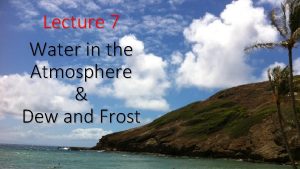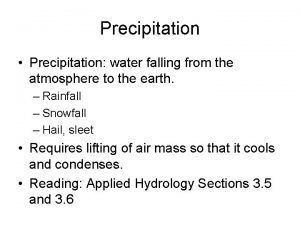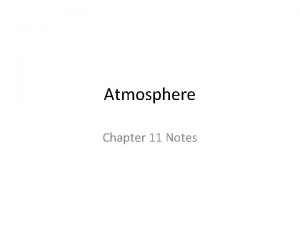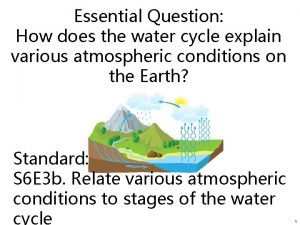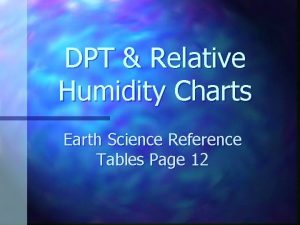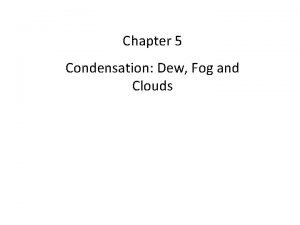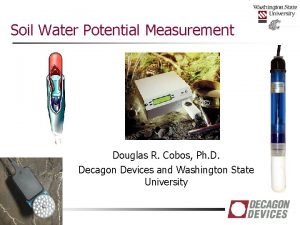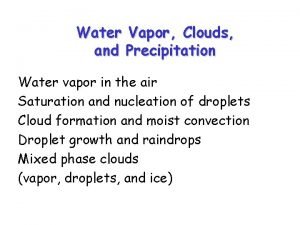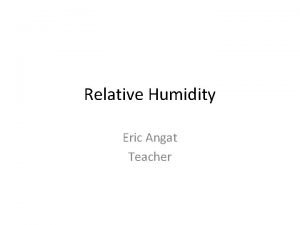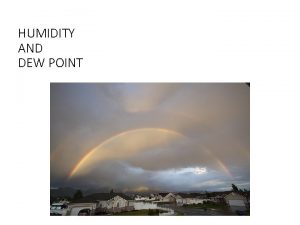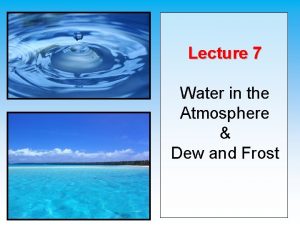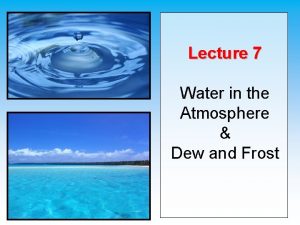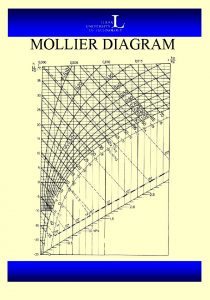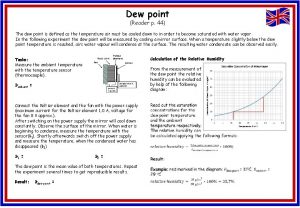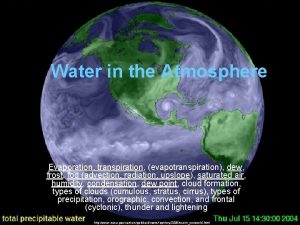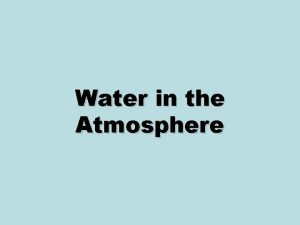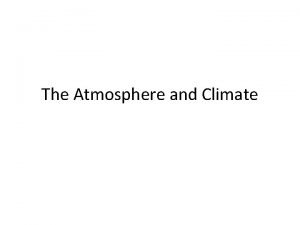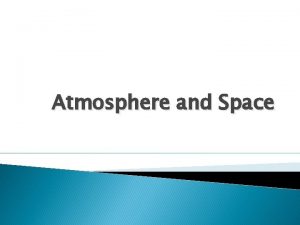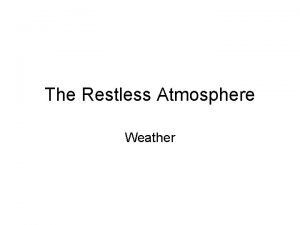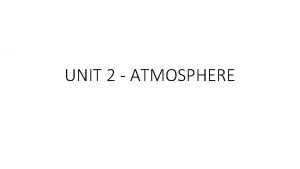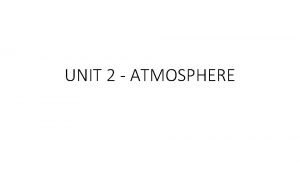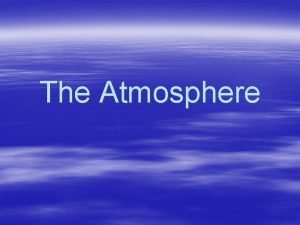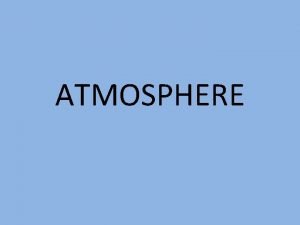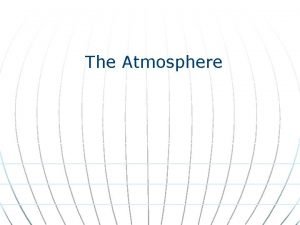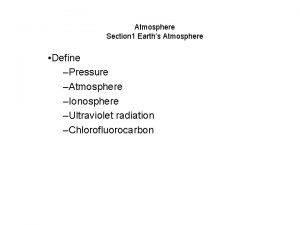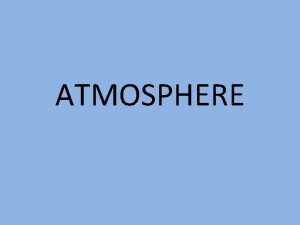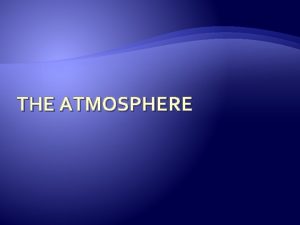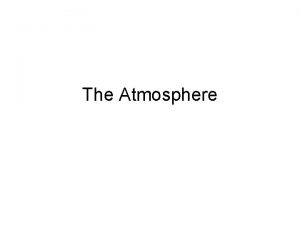Lecture 7 Water in the Atmosphere Dew and





























- Slides: 29

Lecture 7 Water in the Atmosphere & Dew and Frost

Learning Goals for Part 1 of Chapter 4 1. Know the different components of the WATER CYCLE and if energy is released or required. 2. Be able to tell the difference between the different ways we describe HUMIDITY. 3. Know the difference between DEW and FROST. 2

Water – gives life and so much more • Special Properties: • Water easily changes from solid (ice) to liquid to gas (water vapor). • Ice is LESS dense than water so it floats…. • Ice cubes, ice bergs and ice caps…. • Has an unusually high heat capacity • It has a specific heat is 3 times that of land….

Water, water, everywhere, but not a drop to drink…. • Oceans account for most of water (>97%) • Not readily useable by humans or plants • Ice sheets in Antarctica and Greenland (~3%) • Atmosphere has only a little (0. 001%)

Water is Everywhere!!! • Oceans • Glaciers • Rivers • Lakes • Air • Soil • Living tissue (body is made up of 70% water)

“The Hydrologic Cycle” Condensation Evaporation Precipitation Run Off Transpiration Infiltration

1) EVAPORATION REQUIRES ENERGY • The process by which a liquid is transformed into a gas • Happens over Oceans, Lakes, Rivers and other “standing” bodies of water • Powered by the sun! • Solar radiation heats up the water molecules until they are “freed” from the liquid state. • Heat is absorbed during evaporation

2) CONDENSATION RELEASES ENERGY • The change from a gas to a liquid • Responsible for the formation of clouds • Heat is released during condensation

3) PRECIPITATION • Falling liquid or solid in the atmosphere. • Balances Evaporation • Average annual precipitation equals evaporation. • Happens over Land or Oceans • Returns the water to the ocean or soaks into the ground.

4) TRANSPIRATION • The release of water vapor to the atmosphere by plants • Plants uptake water through their roots that fell as precipitation • Not as important as evaporation

Over Land Ocean? • Evaporation exceeds Precipitation over Water • No plants, so no transpiration • Precipitation exceeds Evaporation over Land • Condensation happens everywhere.

SUBLIMATION REQUIRES ENERGY • Conversion of a solid directly to a gas • EX: Gradual shrinking of unused ice cubes, the rapid conversion of dry ice into gas. • How piles of snow tend to disappear even if the air temperature never reaches above 32 F (when air is dry)

DEPOSITION RELEASES ENERGY • Conversion of a gas directly to a solid • EX: Frost on a window pane (white frost, hoar frost… FROST). • EX: Frost the builds up in the freezer. . Was once part of your ice cube! • Happens without passing through an intermediate liquid phase

Water Vapor Content of Air • Humidity • Vapor Pressure • Relative Humidity • Dew Point

Humidity • The general term used to describe the amount of water vapor in the air

Vapor Pressure Dry Air Heat Up More • That part of the total atmospheric pressure attributable to its water-vapor content. • As more water vapor is added to dry air the vapor pressure increases

Vapor Pressure - SATURATION • Initially more molecules leave the surface of the water than return. • Over time: • number of molecules leaving = the number molecules returning • This is SATURATION

Saturation Vapor Pressure • When air is saturated the pressure exerted by the motion of the water vapor molecules is called the Saturation Vapor Pressure. • Varies as a function of temperature • You can “FIT” FIT more water vapor in warmer air.

In the real atmosphere • In nature Gravity is the “LID” LID keeping the water vapor in (like in our jar and test-tube examples) • Atmosphere isn’t always in balance at every second • Net evaporation: evaporation When more water is leaving a surface • Net condensation: condensation When more water is returning to a surface • At saturation net evaporation = net

Relative Humidity • The ratio of the air’s actual water vapor content compared with the amount of water vapor required for saturation at that temperature and pressure (Actual Vapor Pressure) Relative Humidity = Water vapor content Water vapor capacity (Saturation Vapor Pressure) X 100 percent

Natural Changes in Relative Humidity 1. Daily changes in temperatures (daylight verses nighttime temperatures)

Natural Changes in Relative Humidity 2. Temperature changes that result as air moves horizontally from one location to another 3. Temperature changes caused as air moves vertically in the atmosphere REMEMBER: RH Tells us how close to Saturation the Air is… Not how much water vapor is in the air.

Dew Point Temperature • The temperature at which air needs to be cooled to reach saturation • It is a measure of the actual moisture content of a parcel of air. • The term dew point stems from the fact that during the night objects at the surface often cool below the dew-point are a coated with dew.

Dew Point Temperature 59 F – 68 F • When the dew point exceeds ~65 F it is considered humid by most people • A dew point above 75 F is considered unbearable.

Dew • The condensation of water vapor on objects that have cooled to the dew-point. • They radiated away some of their heat. • A car will get dew before the cement since they cool at different rates. • More frequent on grass since plants TRANSPIRE and release water vapor right near the blade!

Frost • Frost is NOT frozen dew. • FROST forms from DEPOSITION • Gas to solid phase • Called white frost or hoar frost

Key Information 1 1. Know the different components of the WATER CYCLE and if energy is released or required. • Evaporation • • Liquid Gas Energy is ABSORBED (Required) • Condensation • • Gas Liquid Energy is RELEASED • Sublimation • • Solid Gas Energy is ABSORBED (Required) • Precipitation • • • NO PHASE CHANGE Rain falls Snow falls • Transpiration • • • Liquid Gas Energy is ABSORBED Just like Evaporation but from plants • Deposition • • Gas Solid Energy is RELEASED 27

Key Information 2 2. Be able to tell the difference between the different ways we describe HUMIDITY. • Vapor Pressure • That part of the total atmospheric pressure attributable to its watervapor content. • As more water vapor is added to dry air the vapor pressure increases. • Relative Humidity • The ratio of the air’s actual water vapor content compared with the amount of water vapor required for saturation at that temperature and pressure • Dew Point • The temperature at which air needs to be cooled to reach saturation • It is a measure of the actual moisture content of a parcel of air. 28

Key Information 3 3. Know the difference between DEW and FROST. • Dew • The condensation of water vapor on objects that have cooled to the dew-point. • Surfaces cool by radiating heat away. • Frost • Not frozen dew • Frost forms from deposition. • Water goes from the gas to the solid phase 29
 Water and water and water water
Water and water and water water 01:640:244 lecture notes - lecture 15: plat, idah, farad
01:640:244 lecture notes - lecture 15: plat, idah, farad Bubble point and dew point calculation
Bubble point and dew point calculation Difference between fog and dew
Difference between fog and dew The devil damn thee black
The devil damn thee black I have a little shadow rhyme
I have a little shadow rhyme Convective rain
Convective rain Water vapor in the atmosphere percentage
Water vapor in the atmosphere percentage Dawn dude rugs
Dawn dude rugs Why does dew form
Why does dew form Earth science reference table relative humidity
Earth science reference table relative humidity Dew clouds
Dew clouds What cloud types would indicate convective turbulence?
What cloud types would indicate convective turbulence? Dew point
Dew point David robert dew
David robert dew Dew point temperature definition
Dew point temperature definition Dew point comfort chart
Dew point comfort chart Crafting the brand positioning
Crafting the brand positioning Mountain dew positioning statement
Mountain dew positioning statement Dr. catherine hart
Dr. catherine hart Jamie has enough money to buy either a mountain dew
Jamie has enough money to buy either a mountain dew Hình ảnh bộ gõ cơ thể búng tay
Hình ảnh bộ gõ cơ thể búng tay Ng-html
Ng-html Bổ thể
Bổ thể Tỉ lệ cơ thể trẻ em
Tỉ lệ cơ thể trẻ em Gấu đi như thế nào
Gấu đi như thế nào Thang điểm glasgow
Thang điểm glasgow Chúa yêu trần thế alleluia
Chúa yêu trần thế alleluia Các môn thể thao bắt đầu bằng tiếng đua
Các môn thể thao bắt đầu bằng tiếng đua Thế nào là hệ số cao nhất
Thế nào là hệ số cao nhất



